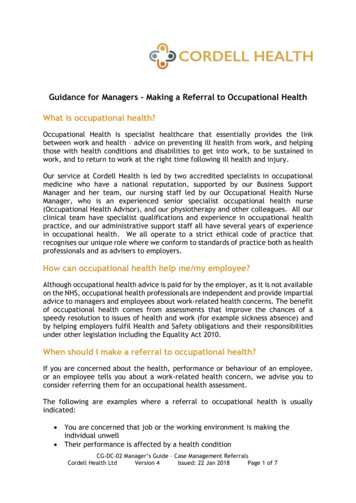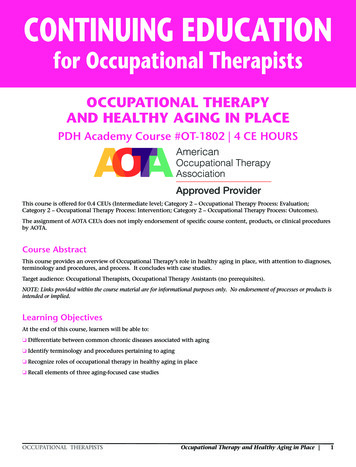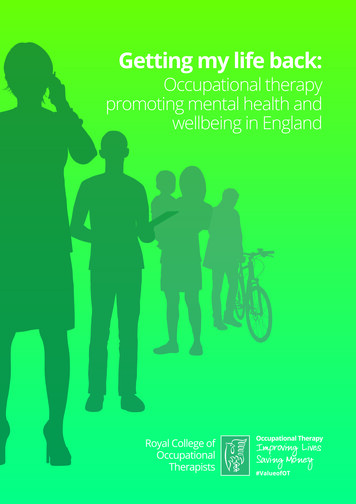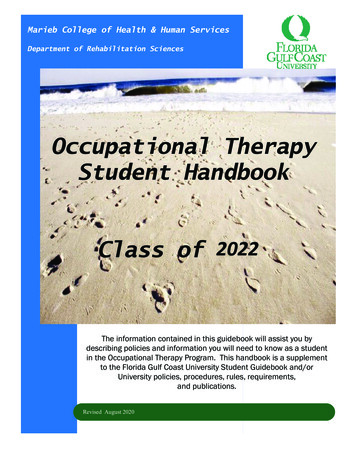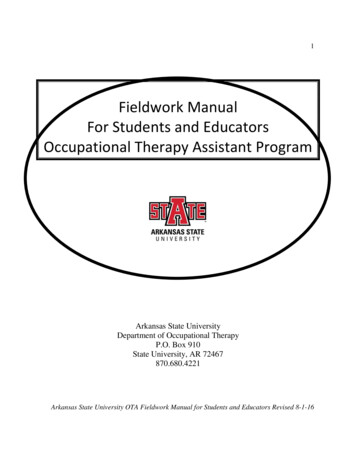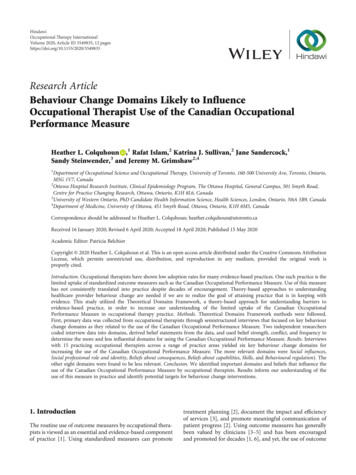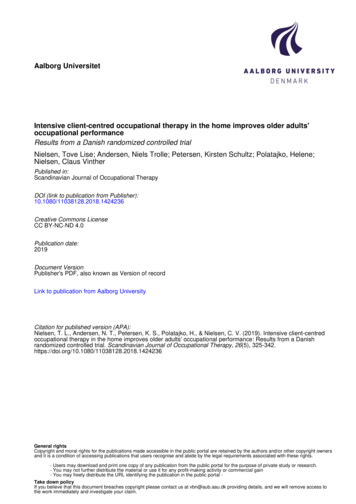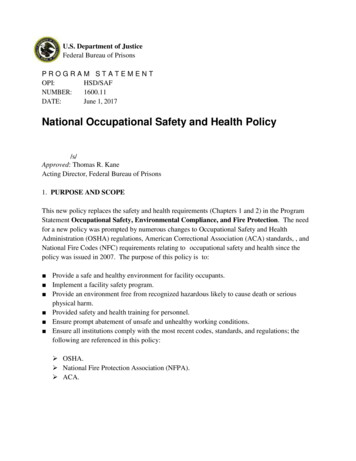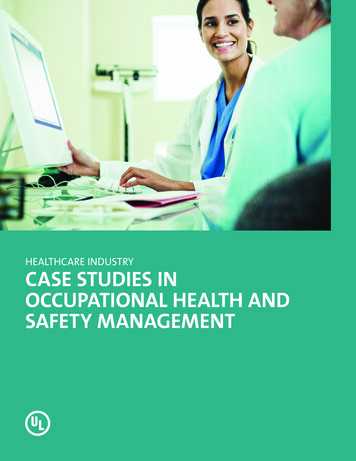
Transcription
HEALTHCARE INDUSTRYCASE STUDIES INOCCUPATIONAL HEALTH ANDSAFETY MANAGEMENT
HEALTHCARE INDUSTRYCase Studies in Workforce Occupational Healthand Safety ManagementIn healthcare settings, it’s helpful to approach regulatory compliance,vaccination campaigns, case management and return to work, training,quality control and record keeping in a dynamic way – not just as processesbut as due diligence.IntroductionIn this booklet, you will learn how:When healthcare organizations practice due diligence, they Baptist Health in Arkansas selected OHM to replace anotherare taking all reasonable precautions to prevent work-relatedsystem and turned a mandatory flu vaccination program thatinjuries and illnesses, enhance safety, and advance the healthwas a “nightmare to administer” into a well-coordinatedof employees and patients. When incidents and accidents occur,effort with positive results.they record and follow up on them.Healthcare employers who strive to identify workplace hazardsand develop plans for corresponding preventive and correctiveactions report positive outcomes. Studies show that injuriesand incidents decline while workforce productivity and morale,compliance and cost containment/revenue generation improve Carolinas Health System serving populations in North andSouth Carolina uses OHM’s robust capabilities to automatemedical surveillance tracking, simplify reporting andultimately give its staff the best possible tools to manageemployee health. Essentia Health in Minnesota provided its staff withwhen there is a culture of health and safety infused throughoutrefresher training to further leverage the power of OHMan organization.and dramatically improve efficiency, produce performanceMany healthcare institutions rely on automated occupationaldashboards for senior executives, and expedite root-causehealth management systems to support their employee healthand safety efforts on a daily basis. The case studies contained inanalysis and preventive measures. Vidant Health in North Carolina is replacing manual,this booklet describe how four hospitals and health systems uselabor-intensive processes with UL’s new mobile vaccine appUL Workplace Health and Safety’s Occupational Health Managerto save significant amounts of staff time and eliminate the(OHM ) solution to achieve their goals.risk of keyboarding errors while enforcing its mandatory fluvaccination policy.These stories illustrate how an investment in an occupationalhealth and safety management system doesn’t cost – it pays.For more information, visit ULworkplace.com/OHM
Case StudyBaptist HealthA health system’s flu vaccination program makes a quickrecovery with a transition to UL Workplace Health andSafety’s OHM software solution.Baptist Health in Arkansas seeks to unite clinicians, employees and patients via the useof technology to deliver total healthcare services throughout the state, including ruralareas. The health system includes seven hospitals, rehabilitation facilities, family clinicsand wellness centers.ChallengeThe Baptist Employee Health Department is responsible for the safety and health ofmore than 7,700 employees. Given the magnitude of this task and the dispersed natureof the workplace, the department needs a comprehensive software program to supporttraining, manage work-related accidents and injuries, track medical surveillance andimmunization activities, and monitor regulatory compliance.When its employee health software vendor announced it would no longer supportits product, Baptist was seriously concerned about how this change would impactoperations, the well-being of its workforce and the quality of patient care.SolutionUpon evaluating the options, Baptist Health selected UL Workplace Health and Safety’sOccupational Health Manager (OHM ) software solution to replace the system that itscurrent vendor was phasing out.UL and the UL logo are trademarks of UL LLC 2013ulworkplace.com
Case StudyResultsFollowing a smooth conversion in spring 2012, the benefits of OHM’s tracking andreporting mechanisms became immediately apparent. For example, managementof Baptist’s mandatory flu vaccination program, once “quite a nightmare,” is now awell-coordinated effort, according to John Landry, safety coordinator.Numbers help tell the story: In 2011, 6,691 employees received flu immunizations over a five-month period, for acompliance rate of 90 percent. In 2012, 7,637 flu immunizations were given between August and December, with a99 percent compliance rate. (There were 7,711 employees in the Baptist Health Systemduring that period.) An additional 849 flu shots were given in 2012 to independent healthcareprofessionals, students, volunteers and other contract personnel.“Getting accurate numbers of active employees who were vaccinated was the biggestbenefit we saw from our ability to track information in OHM,” Landry said. “Previously,our database would not allow us to pull information only on active employees, whichmade it difficult to exclude terminations, employees on family and medical leave, and“ Getting accuratenumbers of the activeemployees who werevaccinated was thebiggest benefit wesaw from our abilityto track informationin OHM.”retirees who might have been vaccinated prior to a change in work status.”Other OHM benefits cited by Landry include the ability to: easily track employees who are vaccinated while in a Baptist Health facility and thosewho receive the vaccination elsewhere – a quality improvement metric. verify the accuracy of the list of those vaccinated by identifying duplicate entries ornames, or flagging missing information in the vaccination record.“This was extremely helpful when tracking so many people in various locations,”he said. “We are already reviewing our 2012-2013 flu campaign and looking forimprovements for the 2013-2014 flu season. Thankfully, most of our evaluation leads usback to processes, not tracking, with the help of OHM.”Beyond the scope of the flu vaccination program, Landry said employee health-John Landrypersonnel use OHM to help them more effectively support Baptist Health’sSafety Director,mission, which emphasizes the values of service, honesty, respect, stewardshipBaptist Healthand performance, combined with a commitment to customer satisfaction throughcontinuous improvement.In September 2012, Baptist Health was recognized as a Customer Achievement Awardwinner at UL Workplace Health and Safety’s User Summit.UL and the UL logo are trademarks of UL LLC 2013ulworkplace.com
Case StudyCarolinas HealthCare SystemUL's OHM software drives greater efficiency,lowers costs and enhances care quality.Carolinas HealthCare System (CHS) is the largest healthcare system in the Carolinas,and the third largest non-profit public healthcare system in the nation. CHS owns,leases or manages 29 hospitals in North and South Carolina and employs more than1,400 physicians practicing in more than 500 locations. CHS also operates rehabilitationhospitals, nursing homes, ambulatory surgery centers, home health agencies, radiationtherapy centers and physical therapy facilities. Together, these operations comprisemore than 6,000 licensed beds and employ more than 44,000 full-time or part-timeemployees.ChallengeThe health system's Employee Health Department used a manual system for tracking,recordkeeping and reporting. The size of the organization and the number of separatelocations and departments required stacks of forms for many critical programs. Beyondconsuming significant resources, the manual approach also meant slow turnaroundtimes and potential for human error throughout the process.CHS wanted to automate medical surveillance tracking, simplify reporting andultimately give Employee Health Department staff the best possible tools to dotheir jobs efficiently and effectively. But other variables had to be considered as well,including cost and the inevitable challenges of implementation, training and upgradeswhen dealing with large organizations.SolutionUL's Workplace Health and Safety Occupational Health Manager (OHM) softwaresolution had all the capabilities CHS was looking for — and more. OHM has beenused by the CHS Employee Health Department since 1998, primarily by nurses, HRassistants and clerks, as well as IS administrators. CHS Director of Employee HealthLydia Crutchfield, RN, BSN, says the transition to an electronic medical record has led togreater efficiency and organization, reduced workplace stress, and better informationfor the managers served by her department.Employee Health Department staff report the power of OHM is experienced mostdirectly in its impact on specific programs: Vaccination Marathon — Batch entry combined with electronic forms helped drivethe phenomenal success of a flu vaccination campaign. Instead of stacks of paperforms that had to be entered into the system later, all data was entered electronicallyin real time. Estimated time saved? Three months of work!UL and the UL logo are trademarks of UL LLC 2013ULworkplace.com
Case StudySolution (Continued) TB Skin Test Surveillance — With the automation of this process, staff now printsforms any time they’re needed, and can easily track and create a list of employeeswho are due or overdue for tests. Health Assessment — OHM has enhanced the department’s ability to ensure thatCHS doesn’t hire anyone who lacks the required vaccinations/immunizations or isotherwise unsuited for a job.ResultsBottom-Line Benefits — OHM has helped drive cost savings and improved businessperformance in key areas: Efficiency — OHM has greatly reduced the time required for tasks such as tracking,recordkeeping and reporting. Risk Management — Timely distribution of information to managers and employeesvia OHM has helped improve efforts to limit exposure and maintain employee health.As a result, CHS has fewer lost work days and related expenses. Compliance — By helping the company maintain and document compliance, OHMhelps CHS avoid potential fines from OSHA and other regulatory agencies.“ Upgrades andenhancements areavailable to help uskeep up with theever-changing worldof technology.”Reporting and Communication Benefits — OHM’s automated reporting has been a bigtime-saver for staff, but other communication improvements have been noted as well: Accountability and Visibility — The ability to easily pull and distribute vaccination andsimilar information for a specific area has enabled managers to be proactive, whilealso improving individual and organization-wide awareness of key health issues. Decision-Making — OHM’s tracking and information-sharing features help staffdeliver the timely, accurate data senior managers need for planning and strategicdecision-making.-Rebecca Jones Seamless Integration — OHM interfaces with other internal databases and systems atCertified Nursing Assistant,CHS, including PeopleSoft, simplifying data transfer between different job functionsCarolinas HealthCare Systemand facilities.Data Integrity and Maintenance Benefits — Automating and electronically storing datahas reduced the potential for human error or data loss.UL and the UL logo are trademarks of UL LLC 2013ULworkplace.com
Case StudyEssentia HealthOHM software refresher training dramatically improvesstaff efficiency and user satisfaction while supporting ahealth system’s long-range workforce protection goals.On the shores of Lake Superior in Duluth, Minn. and surrounding communities, EssentiaHealth-East Region operates St. Mary’s Medical Center, six critical access hospitals, and24 affiliated primary care and multi-specialty facilities. The regional health system hasapproximately 7,300 employees.ChallengeRichard Fisher, manager of workers’ compensation, employee health and loss prevention,and his colleagues must satisfy a host of workplace health and safety requirements.Internal human resource policies, Joint Commission standards, Occupational Health andSafety Administration (OSHA) regulations, and federal mandates such as the Americanswith Disabilities Act, the Family and Medical Leave Act, and the Health Insurance Portabilityand Accountability Act are all on the radar.In addition, the employee health team is responsible for ensuring compliance with aMinnesota law requiring every licensed healthcare facility, including satellite clinics, toimplement a safe patient handling program.While low-back strain and other injuries often occur when caregivers lift and transferpatients, other risks also demand the attention of employee health staff. Slips, trips andfalls, needlestick and sharps injuries, assaults by combative patients and visitors, andpotential exposure to contagious diseases, infections and toxic medications are part ofdaily life.Meanwhile, the department’s primary objectives – injury/illness prevention andmanagement – have been encumbered for years by a paper-based recordkeeping system.“It’s not just the challenge of documentation and complying with standards andregulations,” Fisher said. “That’s the easy part compared to trying to change the culture andget healthcare professionals to have more concern for their own personal well-being.”UL and the UL logo are trademarks of UL LLC 2013ULworkplace.com
Case StudySolutionEssentia-St. Mary’s installed UL’s Workplace Health and Safety Occupational HealthManager (OHM) software in 2000, originally as an internal mainframe application andlater transitioning to an online hosted solution.OHM is a helpful tool because it automates data collection, statistical analysis andreporting. At Essentia, the employee health department also depends on OHM tosupport its transition from paper to electronic records – a major undertaking.When Fisher joined the team in 2011, he quickly realized staff could further streamlineoperations and better align its prevention and management objectives if they receivedrefresher training on the software.He invited an OHM specialist from UL Workplace Health and Safety to spend twodays on site to provide intensive training. Preparation for the site visit included jointdevelopment of an action plan designed to address staff questions and Essentia’sspecific needs.“It was a wonderful experience,” Fisher said. “Everyone loved the approach and thetrainer’s attentiveness. It could not have gone better.”Results“ OHM gives us adistinct advantageby selling prevention,which is my goalin life, and it hassimplified our lives.”Using OHM to produce performance dashboards for senior executives, he is able to tieinjury-related cost data he obtains from Essentia’s third party administrator (TPA) withmedical and indemnity costs by injury type, frequency and job category. Rather thanwait for an annual report from the TPA, the monthly reports he generates help expediteroot-cause analysis and preventive measures.“For instance, now I can go to the chief nursing officer of the region and say, ‘Here arehow many lost time and restricted time days we have had and here is the monthly cost.’That really gets her attention.,” Fisher said.Prior to refresher training, he estimates staff used about 60 percent of OHM’s capacity-Richard Fisherin the modules with which they were familiar and vastly underutilized the remainder.Manager, Essentia HealthWith training, all of the users report they feel much more comfortable with andknowledgeable about the entire system. “With annual refresher training, I believe wewould nearly maximize the capabilities of each module,” he said.With respect to the return on investment in refresher training, Fisher estimates ithas more than paid for itself in terms of performance improvement. Staff membershave noted dramatic decreases in manual tasks, sub-directory searches and pagereformatting and corresponding increases in efficiency and user satisfaction.“UL Workplace Health and Safety has the understanding of all that the software can do,and our partnership with them has tremendous value,” he said. “You can always updatethe software. But when you do, you need to update the people, too.”UL and the UL logo are trademarks of UL LLC 2013ULworkplace.com
Case StudyVidant HealthA major health system uses OHM and UL’s mobile vaccine app tostreamline its mandatory flu vaccination program and open doorsfor other employee health and safety management initiatives.Vidant Health in eastern North Carolina is comprised of 10 hospitals. The systemincludes a flagship medical center in Greenville with 909 licensed and CON-approvedbeds, physician practices, home health, hospice and wellness centers. Its workforce is12,000 strong, plus a fleet of volunteers and suppliers.Formerly University Health Systems of Eastern Carolina, Vidant Health’s goal is to“enhance services that are available locally and eliminate barriers involving time,distance and lack of awareness that sometimes prevent patients from receiving thecare they need.”ChallengeAt Vidant, all staff - caregivers, administrators, vendors and volunteers - are requiredto comply with a mandatory flu vaccination policy that was adopted in 2012. Patientsafety is the driving force. Corresponding benefits include protecting employees anddemonstrating the system’s commitment to providing high-quality care in the safestmanner possible.SolutionVidant installed UL Workplace Health and Safety’s Occupational Health Manager (OHM) solution in October 2011. Vidant Corporate Health Services uses OHM’s robustmonitoring and reporting capabilities to help manage all of its employee healthfunctions including its flu ambassador campaign, flu shot clinics and roving carts, and a“FlexWork” staffing plan for nurses who administer the vaccine.With onsite support from UL customer support, Vidant successfully pilot-tested UL’snew mobile vaccine app during a mock flu clinic at Vidant Medical Center using an iPadconnected to a handheld scanner. The system plans to use the mobile app extensivelythis flu season.UL and the UL logo are trademarks of UL LLC 2013ulworkplace.com
Case StudyResultsDuring the mock flu clinic, Angie Carter, corporate health system analyst inOccupational Health Services at Vidant, and her colleagues set up two lines: one usingthe mobile app and scanner, the other using the traditional manual process, whichinvolves collecting consent forms, keying in the vaccine record and uploading theconsent form to the system.The improvement was dramatic: a 4-to-1 ratio in terms of staff time savings andelimination of the chance for human error in the line where keyboards were replacedwith employee badge scanners."Wow, what a difference," Carter said. "During our mock flu clinic we were able tomanage and process four employees via the mobile vaccine app to every one employeeprocessed manually. Talk about an increase in productivity! The mobile app line rolledso efficiently, it was literally the fast track."“The online consent form contained all the required questions and we were able tocapture the consent with signature, sending it directly to OHM. The vaccine record wasrecorded in real time, so we could literally go straight into the OHM vaccine module andview the record immediately. Compliance satisfied!"“UL has been an awesome partner throughout this whole process.”“ During our mock fluclinic we were able tomanage and processfour employees viathe mobile vaccineapp to every oneemployee processedmanually. Talkabout an increase inproductivity!”- Angie Carter, CorporateHealth System Analyst,Vidant HealthNotably, 99.9 percent of Vidant Health employees and volunteers complied with themandatory vaccination policy in 2012, compared to 74 percent compliance in 2011when compliance was voluntary. A total of 15,000 employees, vendors and volunteerswere vaccinated. The vast majority of vaccines were tracked and verified through OHM.“From my perspective, one of the biggest advantages of OHM is that we can managethe program system-wide, produce reports for various management groups, runlabels, send letters it’s very functional,” said Amy Pearson, R.N., M.P.H., C.O.H.N.-S,administrator, Corporate Health Services.Beyond mandatory flu shots, Pearson said OHM is instrumental in helping her teamdevelop “a structure within our structure” for employee health operations. For example,working with UL, one critical goal is the creation of a custom capability for online eventreporting, starting encounters with supervisors’ input on required examinations.“The flu campaign really opened our eyes to how we can use OHM more effectively inother areas,” Pearson said. “Our experience with that helped build the confidence levelof our staff. They are very comfortable with the information OHM procures.”UL and the UL logo are trademarks of UL LLC 2013ulworkplace.com
BUILDING A SAFE ANDHEALTHY CULTURE - FROMTHE PEOPLE UPAs part of UL, a trusted name in safety for more than a century, UL WorkplaceHealth and Safety helps employers optimize their occupational health and safetyresults. We provide the management, analytical, learning and reporting toolsthey need to succeed, along with the product guidance and industry expertiserequired to create an enduring culture of health and safety.CONTACT US TODAYLearn more about how to develop a culture of health and safety inpartnership with UL.By phone: 1.888.202.3016By email: ULworkplacesales@ul.comVia web: ULworkplace.comUL and the UL logo are trademarks of UL LLC 2013
Many healthcare institutions rely on automated occupational health management systems to support their employee health and safety efforts on a daily basis. The case studies contained in this booklet describe how four hospitals and health systems use UL Workplace Health and Safety's Occupational Health Manager

